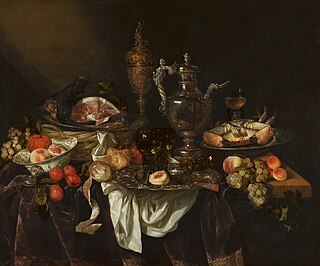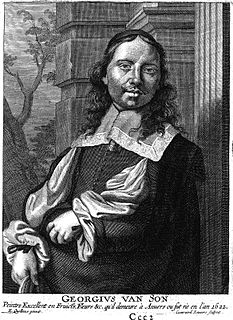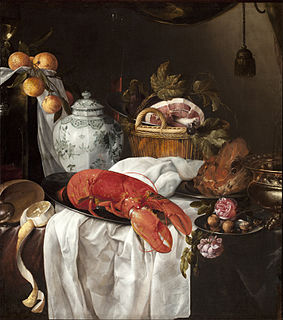
Pronkstilleven (Dutch for 'ostentatious', 'ornate' or 'sumptuous' still life) is a style of ornate still life painting, which was developed in the 1640s in Antwerp from where it spread quickly to the Dutch Republic.

Pronkstilleven (Dutch for 'ostentatious', 'ornate' or 'sumptuous' still life) is a style of ornate still life painting, which was developed in the 1640s in Antwerp from where it spread quickly to the Dutch Republic.
Flemish artists such as Frans Snyders and Adriaen van Utrecht started to paint still lifes that emphasized abundance by depicting a diversity of objects, fruits, flowers and dead game, often together with living people and animals.
The style was soon adopted by artists from the Dutch Republic. [1] A leading Dutch representative was Jan Davidsz. de Heem, who spent a long period of his active career in Antwerp and was one of the founders of the style in Holland. [2] [3] Other leading representatives in Flanders and the Dutch Republic were Nicolaes van Verendael, Alexander Coosemans, Carstian Luyckx, Jasper Geeraards, Peter Willebeeck, Abraham van Beyeren and Willem Kalf. [1]
Cornelis Norbertus Gijsbrechts developed the style further by incorporating pronkstillevens in the trompe-l'œil compositions for which he was known. An example is his Silverware in an Open Cabinet at the Museum of Fine Arts, Ghent. [4]

Pronkstillevens are usually interpreted as a form of vanitas painting that conveys a moral lesson. The various objects in the compositions serve as symbols that can be read as an admonition or a life lesson. The objects usually refer to the transience and emptiness of wealth and possessions and the ultimate extinction and emptiness of earthly life.
For instance, roses are often used as a vanitas motif, as they recall that all life and earthly beauty are fleeting. Hourglasses are an admonition that life is fleeting and will end. Empty containers such as glasses or vases point to the emptiness of earthly wealth and aspirations. The paintings remind the viewer of the need to practice moderation and temperance. [5]

Jan Davidsz. de Heem or in-full Jan Davidszoon de Heem, also called Johannes de Heem or Johannes van Antwerpen or Jan Davidsz de Hem, was a still life painter who was active in Utrecht and Antwerp. He is a major representative of that genre in both Dutch and Flemish Baroque painting.

Abraham Mignon or Minjon, was a still life painter. He is known for his flower pieces, still lifes with fruit, still lifes in forests or grottoes, still lifes of game and fish as well as his garland paintings. His works are influenced by those of Jan Davidszoon de Heem and Jacob Marrel.

Abraham Hendriksz van Beijeren or Abraham van Beyeren was a Dutch Baroque painter of still lifes. Little recognized in his day and initially active as a marine painter, he is now considered one of the most important painters of still lifes, and still lifes of fish and so-called 'pronkstillevens', i.e. sumptuous still lifes of luxurious objects.

Nicolaes van Verendael or Nicolaes van Veerendael was a Flemish painter active in Antwerp who is mainly known for his flower paintings and vanitas still lifes. He was a frequent collaborator of other Antwerp artists to whose compositions he added the still life elements. He also painted a number of singeries, i.e, scenes with monkeys dressed and acting as humans.

Adriaen van Utrecht was a Flemish painter known mainly for his sumptuous banquet still lifes, game and fruit still lifes, fruit garlands, market and kitchen scenes and depictions of live poultry in farmyards. His paintings, especially the hunting and game pieces, show the influence of Frans Snyders. The two artists are considered the main inventors of the genre of the pronkstillevens, i.e. still lifes that emphasized abundance by depicting a diversity of objects, fruits, flowers and dead game, often together with living people and animals. Van Utrecht also painted a number of flower still lifes. He was a regular collaborator with leading Antwerp painters who had been pupils or assistants of Peter Paul Rubens, such as Jacob Jordaens, David Teniers the Younger, Erasmus Quellinus II, Gerard Seghers, Theodoor Rombouts, Abraham van Diepenbeeck and Thomas Willeboirts Bosschaert.

Cornelis Norbertus Gijsbrechts or Gysbrechts was a Flemish painter who was active in the Spanish Netherlands, Germany, Denmark and Sweden in the second half of the seventeenth century. He was a court painter to the Danish royal family. He specialised in trompe-l'œil still lifes, an artistic genre which uses visual tricks to give viewers the illusion that they are not looking at a painting but rather at real three-dimensional objects. He also created many vanitas still lifes.

Hendrick Andriessen, known as Mancken Heyn was a Flemish still-life painter. He is known for his vanitas still lifes, which are made up of objects referencing the precariousness of life, and 'smoker' still lifes, which depict smoking utensils. The artist worked in Antwerp and likely also in the Dutch Republic.

Joris van Son or Georg van Son was a Flemish still life painter who worked in a number of sub-genres but is principally known for his fruit still lifes. He also created flower still lifes, banquet still lifes, vanitas still lifes and pronkstillevens. He is known to have painted fish still lifes representing the Four Elements. He collaborated with figure artists on 'garland paintings', which typically represent a devotional image framed by a fruit or flower garland.

Cornelis van der Meulen or Cornelis Vermeulen, was a Dutch painter who after training in the Dutch Republic had a career in Sweden where he became a court painter. He is known for still lifes of flowers and game, trompe-l'œil and vanitas still lifes, topographical views and portraits.

Alexander Coosemans was a Flemish Baroque painter specialized in still lifes of flower pieces, fruit, and inanimate subjects. He painted vanitas still lifes, pronkstillevens and game pieces.

Carstian Luyckx, also known as the Monogrammist KL, was a Flemish painter and draughtsman who specialized in still lifes in various subgenres including flower still lifes, fruit still lifes, fish still lifes, pronkstillevens, vanitas still lifes, hunting pieces and garland paintings. He also painted animals and a few genre scenes. After starting his career in Antwerp he is believed to have worked later in France.

Jan Pauwel Gillemans the Elder was a Flemish goldsmith and still life painter who is known for his fruit still lifes, flower pieces, vanitas still lifes and pronkstillevens.
David Davidsz de Heem (1570–1632) was a Dutch Golden Age painter.

Franciscus Gijsbrechts, was a Flemish painter of still lifes specialised in vanitas still lifes and trompe-l'œil paintings. He worked in the second half of the seventeenth century in the Spanish Netherlands, Denmark and the Dutch Republic. Like his father, he painted trompe-l'œil still lifes, a still life genre that uses illusionistic means to create the appearance that the painted, two-dimensional composition is actually a three-dimensional, real object.

Peter Willebeeck or Petrus Willebeeck was a Flemish still life painter who was active in Antwerp in the second quarter of the 17th century. He is known for his fruit still lifes, vanitas still lifes, pronkstillevens and banquet pieces executed in a very delicate manner.

Jasper Geerards, Jasper Geerardi or Jasper Geeraerts was a Flemish painter who specialized in still lifes and in particular pronkstillevens. He was active in Antwerp and Amsterdam.

Cornelis de Bryer was a Flemish still life painter who was active in Antwerp in the 1650s. He is known for his fruit still lifes, vanitas still lifes and pronkstillevens.

Andries de Coninck or Andries de Koninck was a Flemish art dealer and still life painter active in Antwerp. He is known for his pronkstillevens, the still lifes that were popular in Flanders and the Dutch Republic from the 1640s.

Jacobus Plasschaert or Jacob Plasschaert, spelling variation of name Plasgaert was a Flemish painter and teacher. He is known for his trompe-l'œil still lifes and vanitas still lifes. He was active in Bruges.

Pieter van Overschie or Pieter van Overschee was a Flemish still life painter who was active in Antwerp between 1640 and 1672. He is known for his fruit still lifes and game still lifes.